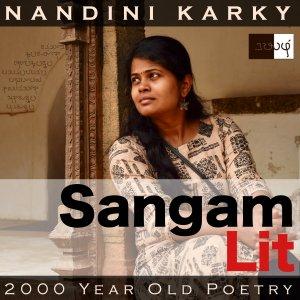Sangam Lit

Aganaanooru 90 – Hard to attain
In this episode, we perceive a subtle technique of persuasion, as depicted in Sangam Literary work, Aganaanooru 90, penned by Madurai Maruthan Ilanaakanaar. The verse is situated in the ‘Neythal’ or ‘Coastal landscape’ and projects how invaluable the lady is to her family.
மூத்தோர் அன்ன வெண் தலைப் புணரி
இளையோர் ஆடும் வரிமனை சிதைக்கும்
தளை அவிழ் தாழைக் கானல் அம் பெருந் துறை,
சில் செவித்து ஆகிய புணர்ச்சி அலர் எழ,
இல்வயிற் செறித்தமை அறியாய்; பல் நாள்
வரு முலை வருத்தா, அம் பகட்டு மார்பின்,
தெருமரல் உள்ளமொடு வருந்தும், நின்வயின்,
”நீங்குக” என்று, யான் யாங்ஙனம் மொழிகோ?
அருந் திறற் கடவுட் செல்லூர்க் குணாஅது
பெருங் கடல் முழக்கிற்று ஆகி, யாணர்,
இரும்பு இடம் படுத்த வடுவுடை முகத்தர்,
கருங் கட் கோசர் நியமம் ஆயினும்,
”உறும்” எனக் கொள்குநர்அல்லர்
நறு நுதல் அரிவை பாசிழை விலையே.
In this little trip to the seas, we get to meet the confidante and hear her say these words to the man, as he arrives to tryst with the lady:
“Having white heads of elders, waves dash against and destroy sand houses, built by the young, in those huge shores, filled with pandanus trees, brimming with blooming flowers. As news of your union fell on a few ears, slander has spread and she has been confined to her home. You know not about this! How can I come to you, who has a handsome, proud chest, which has not had the company of her young bosoms for many days, and whose heart is filled with sorrow and confusion, and say to you, “Let go of her”? On the eastern side of Selloor, known for its powerful gods, is the town of Niyamam, ruled by the fearless Kosars, who have scarred faces, carved by the slash of iron, and here, the huge ocean resounds ceaselessly, and it’s filled with endless prosperity. Even if this town of Niyamam is given as the bride price for their young girl, with a fine forehead, they wouldn’t say, ‘This is fitting’ and accept it!”
Time to take a look at the unending waves in the love life of these ancients! The confidante stops the man when he arrives to tryst with the lady. She describes the shore where they live as one where waves, having the greyed hair of elders, would smash against the sand houses, etched with love by the young. That’s a subtext for what’s to follow! Continuing, the confidante talks about how some people had spread slander about the man’s union with the lady, and because of that, the lady’s parents had confined the lady home. The confidante laments that she does not have the heart to disappoint the man, who is coming there with much passion, and ask him to forget the lady. She concludes by giving the explanation that the lady’s family valued their girl so much that they would not consider even the rich and fertile town of Niyamam, east of Selloor, to be a fitting exchange for their beautiful daughter.
The confidante is nudging the man to give up trysting and marry the lady, warning him that he had his work cut out. ‘Neither will you be able to see her now and if you want to win her over, you have to shower immeasurable riches on the lady’s kith and kin’, she means to say to the man. These lines clearly tell us that this society had the custom of bride price, wherein a man had to render a certain amount of wealth to the girl’s family, prior to their wedding. Curious how this practice has turned topsy turvy and in contemporary Tamil society, some families of girls are expected to pay a ‘dowry’ to the groom’s family. It would be insightful to understand how this diametrically opposite change came about over the centuries, in this particular wedding custom!






 Visit Podcast Website
Visit Podcast Website RSS Podcast Feed
RSS Podcast Feed Subscribe
Subscribe
 Add to MyCast
Add to MyCast